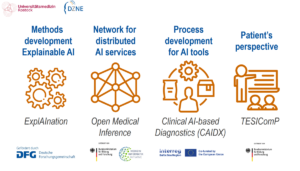In July 2020, I chaired the symposium “Doctor AI: Making computers explain their decisions” at the Alzheimer’s Association International Conference (AAIC). There, next to me, three internationally leading researchers in the field of Alzheimer’s disease and MRI data analysis with machine learning and neural networks presented their exciting talks: Kerstin Ritter (Berlin, Germany), Mohamad Habes (San Antonio, Texas, USA) and James Cole (London, UK). We reported on our projects to make the decision-making of computer-generated models more transparent and comprehensible – a basic requirement for the application of such procedures in clinical assistance systems for diagnostic support.
In my talk, I presented the latest advances in our project on Alzheimer’s detection in MRI images. The method achieves a high detection accuracy of around 90% for dementia and a rather moderate 75% for mild cognitive disorders (against healthy people). In addition, the patterns of atrophied brain regions learned automatically from the neural network, especially the hippocampus, are clinically very relevant. The automatic calculation of the hippocampus volume is already carried out by commercial assistance systems today. In comparison, however, the approach of the neural networks goes beyond simple, established systems, since they work much more sensitively and can also take changes in the shape or contour of the anatomical brain structures into account.
Finally, I presented an approach with which descriptions and explanations can be generated directly from neural networks. This would make it possible to receive reports directly from the models about which brain changes were detected and how these may be clinically rated. Up to now, this has only been possible with extensive processing steps and statistical comparisons. A real “artificial intelligence” that has such capabilities would be a milestone in research on machine learning and assistance systems.




